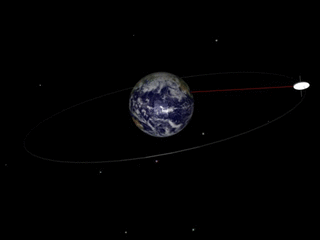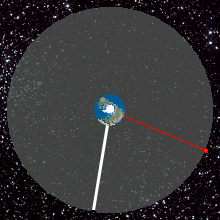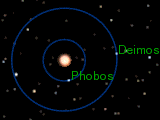|
Subsynchronous Orbit
A subsynchronous orbit is an orbit of a satellite that is nearer the planet than it would be if it were in synchronous orbit, i.e. the orbital period is less than the sidereal day of the planet. Technical considerations An Earth satellite that is in (a prograde) subsynchronous orbit will appear to drift eastward as seen from the Earth's surface. Economic importance in commercial spaceflight The '' Geosynchronous-belt subsynchronous orbital regime'' is regularly used in spaceflight. This orbit is typically used to house working communication satellites that have not yet been deactivated, and may be still be used again in geostationary service if the need arises. See also *Supersynchronous orbit *List of orbits This is a list of types of gravitational orbit classified by various characteristics. Common abbreviations List of abbreviations of common Earth orbits List of abbreviations of other orbits Classifications The following is a list of t ... References ... [...More Info...] [...Related Items...] OR: [Wikipedia] [Google] [Baidu] [Amazon] |
Orbit
In celestial mechanics, an orbit (also known as orbital revolution) is the curved trajectory of an object such as the trajectory of a planet around a star, or of a natural satellite around a planet, or of an artificial satellite around an object or position in space such as a planet, moon, asteroid, or Lagrange point. Normally, orbit refers to a regularly repeating trajectory, although it may also refer to a non-repeating trajectory. To a close approximation, planets and satellites follow elliptic orbits, with the center of mass being orbited at a focal point of the ellipse, as described by Kepler's laws of planetary motion. For most situations, orbital motion is adequately approximated by Newtonian mechanics, which explains gravity as a force obeying an inverse-square law. However, Albert Einstein's general theory of relativity, which accounts for gravity as due to curvature of spacetime, with orbits following geodesics, provides a more accurate calculation and u ... [...More Info...] [...Related Items...] OR: [Wikipedia] [Google] [Baidu] [Amazon] |
Satellite
A satellite or an artificial satellite is an object, typically a spacecraft, placed into orbit around a celestial body. They have a variety of uses, including communication relay, weather forecasting, navigation ( GPS), broadcasting, scientific research, and Earth observation. Additional military uses are reconnaissance, early warning, signals intelligence and, potentially, weapon delivery. Other satellites include the final rocket stages that place satellites in orbit and formerly useful satellites that later become defunct. Except for passive satellites, most satellites have an electricity generation system for equipment on board, such as solar panels or radioisotope thermoelectric generators (RTGs). Most satellites also have a method of communication to ground stations, called transponders. Many satellites use a standardized bus to save cost and work, the most popular of which are small CubeSats. Similar satellites can work together as groups, forming constellatio ... [...More Info...] [...Related Items...] OR: [Wikipedia] [Google] [Baidu] [Amazon] |
Synchronous Orbit
A synchronous orbit is an orbit in which an orbiting body (usually a satellite) has a period equal to the average rotational period of the body being orbited (usually a planet), and in the same direction of rotation as that body. Simplified meaning A synchronous orbit is an orbit in which the orbiting object (for example, an artificial satellite or a moon) takes the same amount of time to complete an orbit as it takes the object it is orbiting to rotate once. Properties A satellite in a synchronous orbit that is both equatorial and circular will appear to be suspended motionless above a point on the orbited planet's equator. For synchronous satellites orbiting Earth, this is also known as a geostationary orbit. However, a synchronous orbit need not be equatorial; nor circular. A body in a non-equatorial synchronous orbit will appear to oscillate north and south above a point on the planet's equator, whereas a body in an elliptical orbit will appear to oscillate eastward and ... [...More Info...] [...Related Items...] OR: [Wikipedia] [Google] [Baidu] [Amazon] |
Sidereal Day
Sidereal time ("sidereal" pronounced ) is a system of timekeeping used especially by astronomers. Using sidereal time and the celestial coordinate system, it is easy to locate the positions of celestial objects in the night sky. Sidereal time is a "time scale that is based on Earth's rate of rotation measured relative to the fixed stars". A sidereal day (also known as the sidereal rotation period) represents the time for one rotation about the planet axis relative to the stars. Viewed from the same location, a star seen at one position in the sky will be seen at the same position on another night at the same time of day (or night), if the day is defined as a sidereal day. This is similar to how the time kept by a sundial (Solar time) can be used to find the location of the Sun. Just as the Sun and Moon appear to rise in the east and set in the west due to the rotation of Earth, so do the stars. Both solar time and sidereal time make use of the regularity of Earth's rot ... [...More Info...] [...Related Items...] OR: [Wikipedia] [Google] [Baidu] [Amazon] |
Retrograde Motion
Retrograde motion in astronomy is, in general, orbital or rotational motion of an object in the direction opposite the rotation of its primary, that is, the central object (right figure). It may also describe other motions such as precession or nutation of an object's rotational axis. Prograde or direct motion is more normal motion in the same direction as the primary rotates. However, "retrograde" and "prograde" can also refer to an object other than the primary if so described. The direction of rotation is determined by an inertial frame of reference, such as distant fixed stars. In the Solar System, the orbits around the Sun of all planets and dwarf planets and most small Solar System bodies, except many comets and few distant objects, are prograde. They orbit around the Sun in the same direction as the sun rotates about its axis, which is counterclockwise when observed from above the Sun's north pole. Except for Venus and Uranus, planetary rotations around their a ... [...More Info...] [...Related Items...] OR: [Wikipedia] [Google] [Baidu] [Amazon] |
Geosynchronous Orbit
A geosynchronous orbit (sometimes abbreviated GSO) is an Earth-centered orbit with an orbital period that matches Earth's rotation on its axis, 23 hours, 56 minutes, and 4 seconds (one sidereal day). The synchronization of rotation and orbital period means that, for an observer on Earth's surface, an object in geosynchronous orbit returns to exactly the same position in the sky after a period of one sidereal day. Over the course of a day, the object's position in the sky may remain still or trace out a path, typically in a figure-8 form, whose precise characteristics depend on the orbit's inclination and eccentricity. A circular geosynchronous orbit has a constant altitude of . A special case of geosynchronous orbit is the geostationary orbit (often abbreviated ''GEO''), which is a circular geosynchronous orbit in Earth's equatorial plane with both inclination and eccentricity equal to 0. A satellite in a geostationary orbit remains in the same position in the sky to observers ... [...More Info...] [...Related Items...] OR: [Wikipedia] [Google] [Baidu] [Amazon] |
Spaceflight
Spaceflight (or space flight) is an application of astronautics to fly objects, usually spacecraft, into or through outer space, either with or without humans on board. Most spaceflight is uncrewed and conducted mainly with spacecraft such as satellites in orbit around Earth, but also includes space probes for flights beyond Earth orbit. Such spaceflights operate either by telerobotic or autonomous control. The first spaceflights began in the 1950s with the launches of the Soviet Sputnik satellites and American Explorer and Vanguard missions. Human spaceflight programs include the Soyuz, Shenzhou, the past Apollo Moon landing and the Space Shuttle programs. Other current spaceflight are conducted to the International Space Station and to China's Tiangong Space Station. Spaceflights include the launches of Earth observation and telecommunications satellites, interplanetary missions, the rendezvouses and dockings with space stations, and crewed spaceflights on sci ... [...More Info...] [...Related Items...] OR: [Wikipedia] [Google] [Baidu] [Amazon] |
Communication Satellites
A communications satellite is an artificial satellite that relays and amplifies radio telecommunication signals via a transponder; it creates a communication channel between a source transmitter and a receiver at different locations on Earth. Communications satellites are used for television, telephone, radio, internet, and military applications. Many communications satellites are in geostationary orbit above the equator, so that the satellite appears stationary at the same point in the sky; therefore the satellite dish antennas of ground stations can be aimed permanently at that spot and do not have to move to track the satellite. Others form satellite constellations in low Earth orbit, where antennas on the ground have to follow the position of the satellites and switch between satellites frequently. The radio waves used for telecommunications links travel by line of sight and so are obstructed by the curve of the Earth. The purpose of communications satellites is to relay ... [...More Info...] [...Related Items...] OR: [Wikipedia] [Google] [Baidu] [Amazon] |
Geostationary Orbit
A geostationary orbit, also referred to as a geosynchronous equatorial orbit''Geostationary orbit'' and ''Geosynchronous (equatorial) orbit'' are used somewhat interchangeably in sources. (GEO), is a circular orbit, circular geosynchronous orbit in altitude above Earth's equator, in radius from Earth's center, and following the retrograde and prograde motion, direction of Earth's rotation. An object in such an orbit has an orbital period equal to Earth's rotational period, one sidereal time, sidereal day, and so to ground observers it appears motionless, in a fixed position in the sky. The concept of a geostationary orbit was popularised by the science fiction writer Arthur C. Clarke in the 1940s as a way to revolutionise telecommunications, and the first satellite to be placed in this kind of orbit was launched in 1963. Communications satellites are often placed in a geostationary orbit so that Earth-based satellite dish, satellite antennas do not have to rotate to track t ... [...More Info...] [...Related Items...] OR: [Wikipedia] [Google] [Baidu] [Amazon] |
Supersynchronous Orbit
A supersynchronous orbit is either an orbit with a period greater than that of a synchronous orbit, or just an orbit whose major axis is larger than that of a synchronous orbit. A synchronous orbit has a period equal to the rotational period of the body which contains the barycenter of the orbit. Geocentric supersynchronous orbits One particular supersynchronous orbital regime of significant economic value to Earth commerce is a band of near-circular Geocentric orbits beyond the geosynchronous belt—with perigee altitude above , approximately above synchronous altitude —called the geo graveyard belt. The geo graveyard belt orbital regime is valuable as a storage and disposal location for derelict satellite space debris after their useful economic life is completed as geosynchronous communication satellites. Artificial satellites are left in space because the economic cost of removing the debris would be high, and current public policy does not require nor incentivize ... [...More Info...] [...Related Items...] OR: [Wikipedia] [Google] [Baidu] [Amazon] |
List Of Orbits
This is a list of types of gravitational orbit classified by various characteristics. Common abbreviations List of abbreviations of common Earth orbits List of abbreviations of other orbits Classifications The following is a list of types of orbits: Centric classifications * Galactic Center, Galactocentric orbit: An orbit about the center of a galaxy. The Sun follows this type of orbit about the Galactic Center of the Milky Way. * Heliocentric orbit: An orbit around the Sun. In the Solar System, all planets, comets, and asteroids are in such orbits, as are many artificial satellites and pieces of space debris. Moons#Moons of the Solar system, Moons by contrast are not in a heliocentric orbit but rather orbit their parent object. * Geocentric orbit: An orbit around the planet Earth, such as that of the Moon or of artificial satellites. * Selenocentric orbit (named after Selene): An orbit around Earth's Moon. * Areocentric orbit (named after Ares): An orbit around the pl ... [...More Info...] [...Related Items...] OR: [Wikipedia] [Google] [Baidu] [Amazon] |







